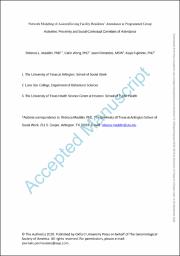
ATTENTION: The works hosted here are being migrated to a new repository that will consolidate resources, improve discoverability, and better show UTA's research impact on the global community. We will update authors as the migration progresses. Please see MavMatrix for more information.
Show simple item record
| dc.contributor.author | Mauldin, Rebecca L. | |
| dc.contributor.author | Wong, Carin | |
| dc.contributor.author | Fernandez, Jason | |
| dc.contributor.author | Fujimoto, Kayo | |
| dc.date.accessioned | 2020-09-30T17:40:44Z | |
| dc.date.available | 2020-09-30T17:40:44Z | |
| dc.date.issued | 2020-09-28 | |
| dc.identifier.issn | 0016-9013 | |
| dc.identifier.issn | 1758-5341 | |
| dc.identifier.uri | http://hdl.handle.net/10106/29456 | |
| dc.description.abstract | **Please note that the full text is embargoed** ABSTRACT: Background and Objectives: Social engagement, including participation in group activities, supports older adults’ mental and physical health. However, many residents of assisted living facilities do not participate in their facility’s programmed group activities. Explaining residents’ attendance at group activities is complex; attendance is associated with a confluence of individual-level and contextual factors. The aim of this study was to assess the effects of multi-level factors on attendance, including residents’ proximity to activity location and the potential for one resident’s attendance to depend on other residents’ attendance.
Research Design and Methods: We used bipartite random graph models (ERGMs) to examine the attendance of 35 residents at 563 programmed group activities. We simultaneously modeled the effects of the geospatial distance from a resident’s apartment to the activity and the tendency for residents to attend activities with similar groups of other residents (i.e., shared attendance) on the likelihood of attendance, while controlling for individual-level factors (demographic and health indicators) and activity popularity.
Results: Greater distance was associated with a reduced likelihood of attendance (p<.001) and residents tended to attend activities with similar subsets of other residents (p<.001).
Discussion and Implications: Findings suggest greater distance to group activities may be a barrier to attendance. Implications include facility design, placement of activities and apartments, and mobility-related strategies to increase activity participation. The social context of activity participation is also important to recognize. We recommend that proximity to activities and social contextual factors be considered in future examinations of attendance at group activities.
[This is an accepted manuscript of an article published by Oxford University Press in "Gerontologist" on Sep. 28, 2020, available online: https://academic.oup.com/gerontologist/advance-article-abstract/doi/10.1093/geront/gnaa149/5912615] | en_US |
| dc.language.iso | en_US | en_US |
| dc.publisher | Oxford University Press | en_US |
| dc.relation.ispartofseries | Gerontologist; | |
| dc.subject | Social roles & Social Factors | en_US |
| dc.subject | Social networks | en_US |
| dc.subject | Environment (i.e., ergonomics) | en_US |
| dc.subject | Bipartite Exponential Random Graph Models | en_US |
| dc.subject | Geospatial distance | en_US |
| dc.title | Network Modeling of Assisted Living Facility Residents’ Attendance at Programmed Group Activities: Proximity and Social Contextual Correlates of Attendance | en_US |
| dc.type | Article | en_US |
Files in this item
- Name:
- gnaa149.pdf
- Size:
- 994.0Kb
- Format:
- PDF
- Description:
- PDF
This item appears in the following Collection(s)
Show simple item record


